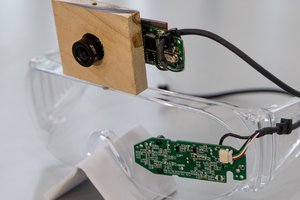This project is a very simple modular solution. The whole project will be fully documented and released Open Book under OBFL Launchpad license.
The hardware for the reference model consists of a Raspberry Pi with camera, and a AAXA Technologies micro-projector. Any projector and any Linux SBC with Video4Linux camera will work with the software. The stylus hardware will probably be a Teensy (since I have one on hand, and it is super simple for a beginner to use). My drawing calls for a PIC, which is probably the right hardware choice for power consumption and no unnecessary complexity, but the software stack is a bit much for the average beginner, and I want this to be as simple as possible for anyone to build.
The whiteboard: it will be a headless linux application, allowing multiple front-ends to exist. The whiteboard itself will be accessed through an OAUTH API. The stylus is implemented as a module. Other types of stylus can be created. The stylus will operate by viewing the RaspiCam, applying a simple math transform (all explained in the Book), and determining cursor position, angle, and intensity. The intensity is controlled by a pressure transducer on the stylus, which modulates the 2 LEDs color to transmit the data to the camera. The angle is determined by the seperation between the 2 LEDs. This allows a chisel-tip such as a whiteboard marker to be emulated.
There will be a modular API for adding tools to the whiteboard. Example tools would be: color change, "brush" change, shapes, charts, graphs, file load, etc.
A reference web application will be created which communicates with the backend API to create a functioning whiteboard. Access can be shared through this web site or directly through the API at the user's discretion.
A blackboard can be simulated too. The stylus could easily emulate chalk. More than that, a different or simpler stylus can be made. A stylus can be made using only 1 LED and a simple on-off. A stylus can be made which doesn't use the camera to communicate. The whole platform is open-ended and open-source.
Design Goals
- Low Cost (the prototype is $300 nominal, though I own all the parts already, and the projector takes up 2/3 of the cost)
- Portable, so that someone can take it into a conference room or whatever
- Simple enough that beginners can understand how to build it, and how to modify it to suit their needs
- Allow physical drawing with a stylus (using a mouse to draw is not the same skill as whiteboarding, and doesn't let ideas flow the same, using a finger is also different from holding a stylus)


 John Evans
John Evans

 Jerry Isdale
Jerry Isdale
 Dan Schneider
Dan Schneider
Not sure if this is of any use but I've seen hacks where people use these IR touch frame things with whiteboards - https://www.aliexpress.com/item/42-inch-USB-Multi-Touch-Screen-Truly-2-points-multi-touch-IR-frame-42-IR-Multi/32609727133.html